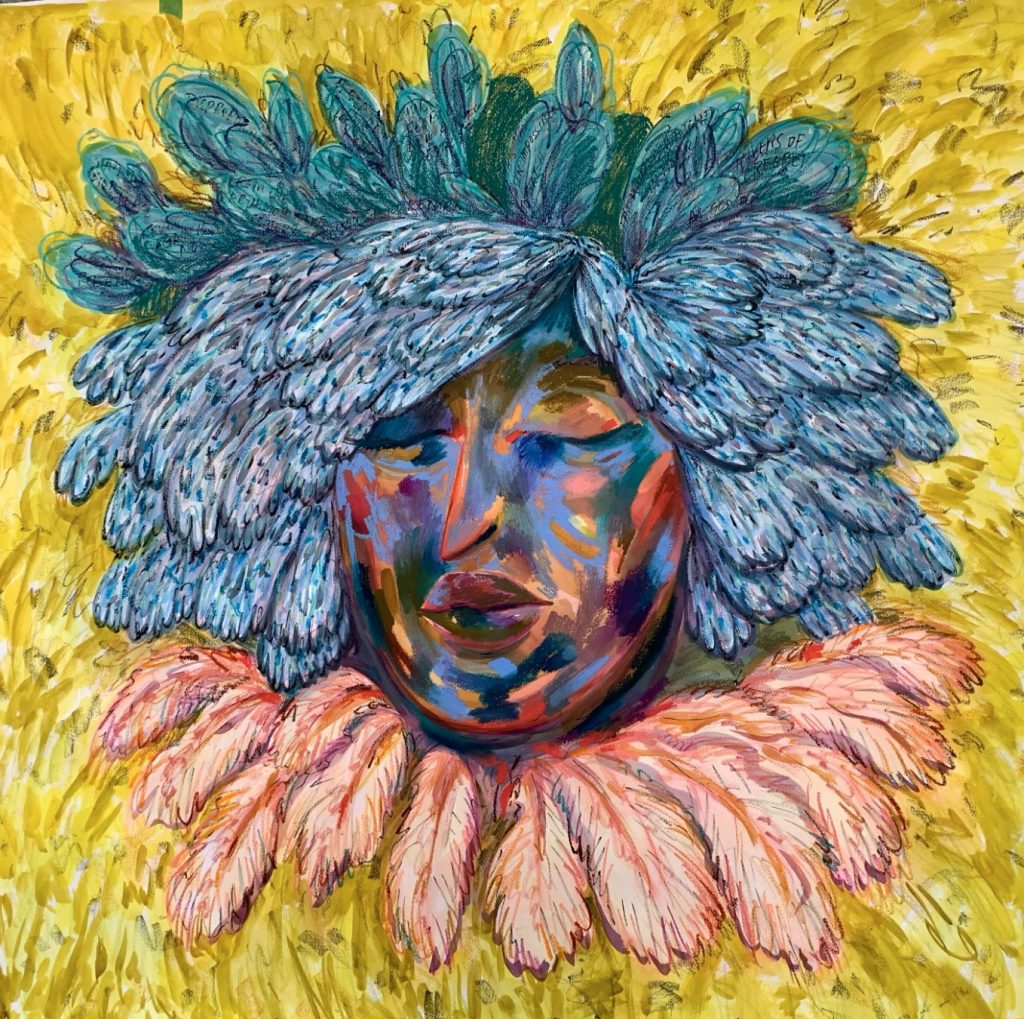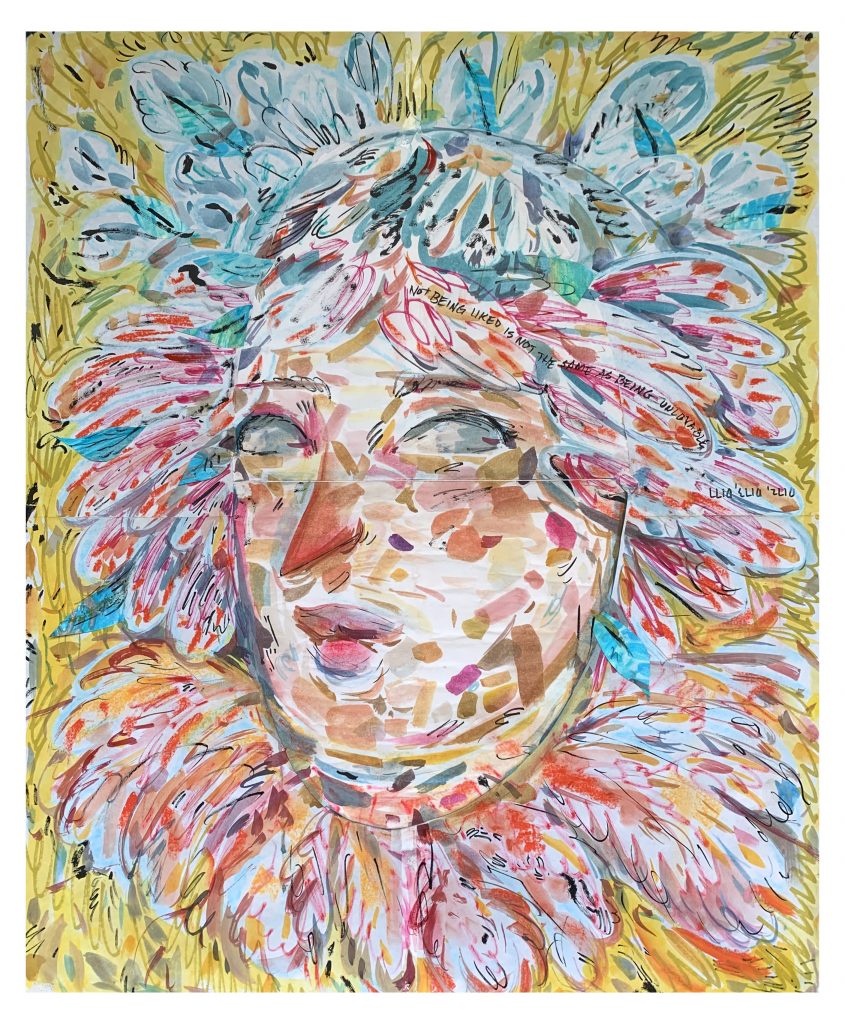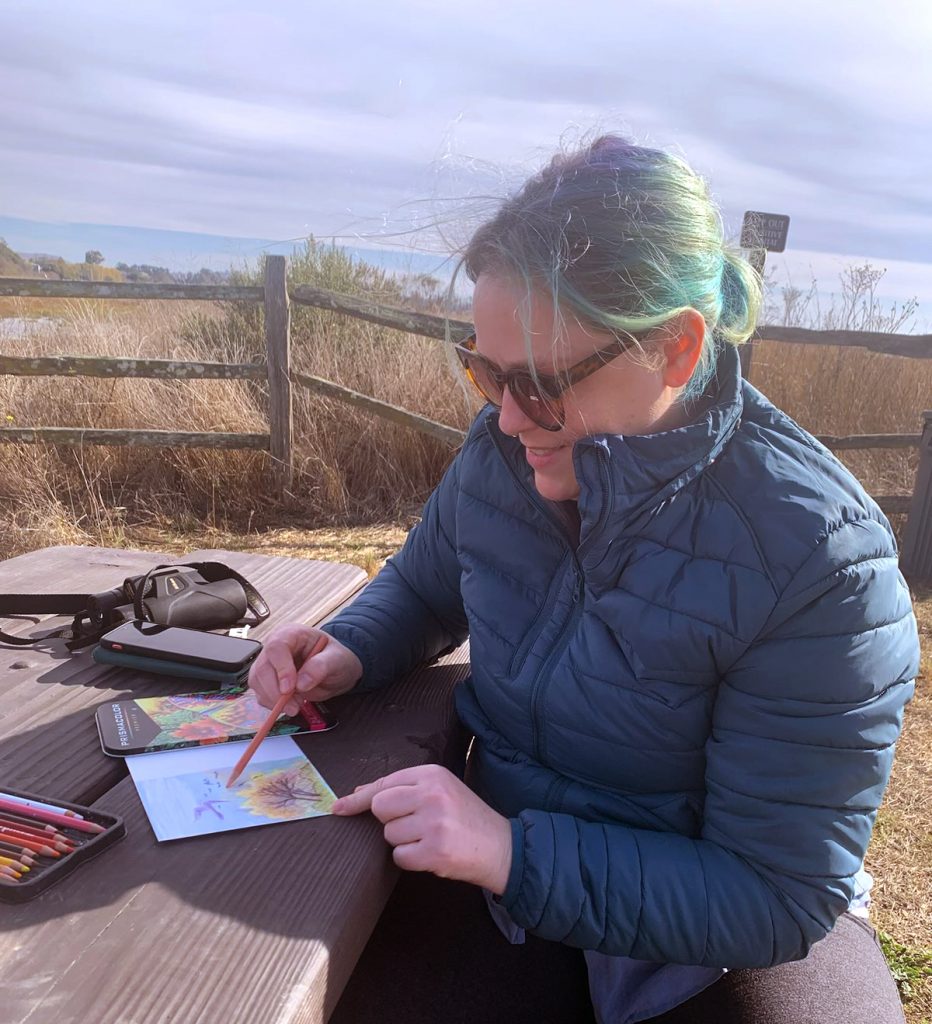June 25, 2024
The American Art Therapy Association represents a diversity of professionals, students, and organizations across the nation. We recognize and celebrate the work of our members at all levels through our Featured Member series.
We invite Featured Members to share their insights about their work, clients, and art therapy journey. This Pride Month, we are focusing on the work and experiences of our LGBTQ+ members.

< Untitled, 2024
Mixed media: ink, watercolor & gouache, water soluble oil pastel, oil pastel, watercolor pencil
Jess Minckley
What Does Pride Mean to You?
1. Pride is a way to honor the people who lost part of themself and/or their lives fighting for recognition, acceptance, and dignity, including Marsha P. Johnson. To our forebears, we pay homage to the parts you sacrificed because the world could not tolerate difference.
2. Pride celebrations are a time when visibility can be less life threatening. We are living through an epoch of regression and repression in the U.S., where civil rights are being stripped away from transgender and other queer people. Being in exclusive communities we can feel safer—in groups.
3. For allies, Pride is a moment not about buying rainbow pencil bags and beer koozies from Target, but about being able to really be the safe person for someone who wants to be Out. Educate yourself. Not even queer people know all there is to know about each other. If you have someone in your life who has divulged their queerness to you, read up on their particular identity location. It shows you care. Also, do some soul searching about your internalized biases, assumptions, and your own sexual and gender identities.
4. Pride is a way to make it okay for people who are still hiding in their bodies, their workplaces, who aren’t out in their families of origin, who are questioning their sexuality and/or gender, and who may feel it’s better to not exist than to be strange, different, or “bad”. For those of us who have sacrificed friends, family members, jobs, and other rights to be out, we carry the torch for our siblings who cannot yet speak up for themselves and we pray they don’t die before they can.
5. Although I am “out” about various queer identities, I am consistently misgendered and/or not recognized in workplaces, the art world, by my family and friends, and among other professional art therapists including in my doctoral program. I express Pride for myself and my comrades who have to work so hard to be (and may never be) understood, accepted, and appreciated just for being our unique selves. We recognize the inherent struggle and danger in demanding to be true to ourselves.
What excites you most about your job right now?
Has working with a particular client group shaped your professional focus or specialty?
I work with people in the LGBTQIA+++ community who have survived the developmental traumas of living with parents who have a personality disorder. I use a combination of art therapy, somatic work, EMDR, and I offer ketamine-assisted psychotherapy—all online. Ketamine-assisted psychotherapy (or KAP) is when a therapist attends to someone who has been prescribed ketamine (by a medical doctor) and the therapist is trained to attend to them before (planning), during their psychedelic experience, and after (to integrate). This hyper-specific demographic has often developed obsessive/compulsive symptoms and often chronic illness(es).
My very specific niche found me! It’s my karmic fate my family motivated me to seek truth in my life and I fell into this profession at the end of a winding road.
I learn from my clients about slowness, continuing to be humbled by the power of our formative experiences on our private logic, and how creative we can get in solving life’s problems. I describe the brain as a house with all the lights on. I describe trauma as going through the house and turning certain lights off. I love when the lights come back on and when people have epiphanies that lead to profound change. I feel blessed to witness this process and travel the road alongside them.
“It’s OK to forge your own path;
don’t let anyone try to talk you into not being you.
There’s room for everyone here. “
— Jess Minckley, MFA, MA, LMHC, ACMHC, NCC, ATR, PhDc
How have race or diversity impacted your work as an art therapist?
I care about these issues, and in my opinion, sometimes testaments to DEI fall flat and become performative, so I’ll try to get specific.
As a white person, I will be learning for my lifetime how to become more humble. I encourage my white art therapist colleagues to join me!
I make mistakes. Often. I negatively impact other people. And, repair after relational rupture is one of the most healing things a person (or art therapist) can attempt. I believe in making amends and reparations. Then, I try to forgive myself with loving kindness and move, as Jack Kornfeld says, “on to the next mistake”. This is a liberatory practice.
I do hold marginalized identities as well as privileges. I use the privilege to fight for justice and equity. I lean into my exclusive ecommunities to protect my marginalized selves and to find the care I can’t always get through adequate recognition or representation.
What are your hopes for the future of the art therapy profession?
My hope is that art therapy education can take what has been learned from other disciplines about best practices and apply it with cultural humility. We have a long way to grow toward truly inclusive, respectful, and evolved educational practices that do not harm marginalized students and clients.

< Untitled, 2020
Mixed media: ink, watercolor & gouache, water soluble oil pastel, oil pastel, watercolor pencil
Jess Minckley
Artist Statement
My work has always been about relational rupture. Themes of trauma, heartbreak, aloneness, betrayal, confusion, and lack of belonging are depicted.
This emotionality is represented using the “private language” of art. It has seemed taboo to address this subject matter.
There are unspoken rules about who gets to speak what kinds of truth in what space.
Art’s formal language can obfuscate and make palatable the difficult truths that are sometimes unbearable to tell.
What advice would you give someone interested in pursuing a career in art therapy?
First, try art therapy—or even regular therapy! I’ve known so many people who have started their education without ever going to therapy. How can you know that this is the house you want to buy if you haven’t even stepped inside?
Secondly, VET YOUR SCHOOL. Talk to tons of alumnx about their experiences—positive and negative. If you have marginalized identities, talk to current students who share those identities.
You can read some art therapy books. Dr. Erin Partridge wrote “Getting On in the Creative Arts Therapies: A Hands-On Guide to Personal and Professional Development,” published by Jessica Kingsley, which I contributed to. It can help new professionals as well.
How did you get involved with AATA?
I was a local chapter board member before I moved back to California. I joined AATA as a student and learned so much and met so many people and got many opportunities from the MyAATA Forum. I highly recommend it, you will feel like part of something bigger.
What keeps me excited is the amazing things I learn and the people I get to meet. I get to speak with them about fascinating things like neuroscience! I’ve been a participant in master and doctoral level research projects as a result. I got to know some of the pioneers and people whose textbooks I read in school—some of them even know my name! I find belonging and reassurance among members who hold my beliefs in activism, liberatory practice, and having a sense of humor.
About Jess Minckley, MFA, MA, LMHC, ACMHC, NCC, ATR, PhDc

Jess Minckley (they/them) is an artist, educator, illustrator & designer, mental health counselor (LMHC/ACHMC) and Registered Art Therapist (ATR) who lives and works in Los Angeles, CA.
They earned a Bachelor of Fine Arts (2005) in painting with a minor in creative writing, and a Master of Fine Arts (2013) degree in studio art from Otis College of Art & Design.
They also received a Master of Arts in Clinical Mental Health Counseling with specialization in Creative Arts Therapies (2022) from Antioch University Seattle, and are a PhD candidate (2026) at Dominican University of California.
Minckley works in a variety of art media including drawing/painting, sculpture, performance & video, and is a writer of creative nonfiction and research texts. Their works have been published and exhibited internationally.
Minckley’s private practice Pacific Art Therapy is highly specialized in working with queer adult children of parents with personality disorders who have obsessive-compulsive symptoms using EMDR, Ketamine-assisted psychotherapy, and art therapy via telehealth.
Connect with Jess at www.pacificarttherapy.com
